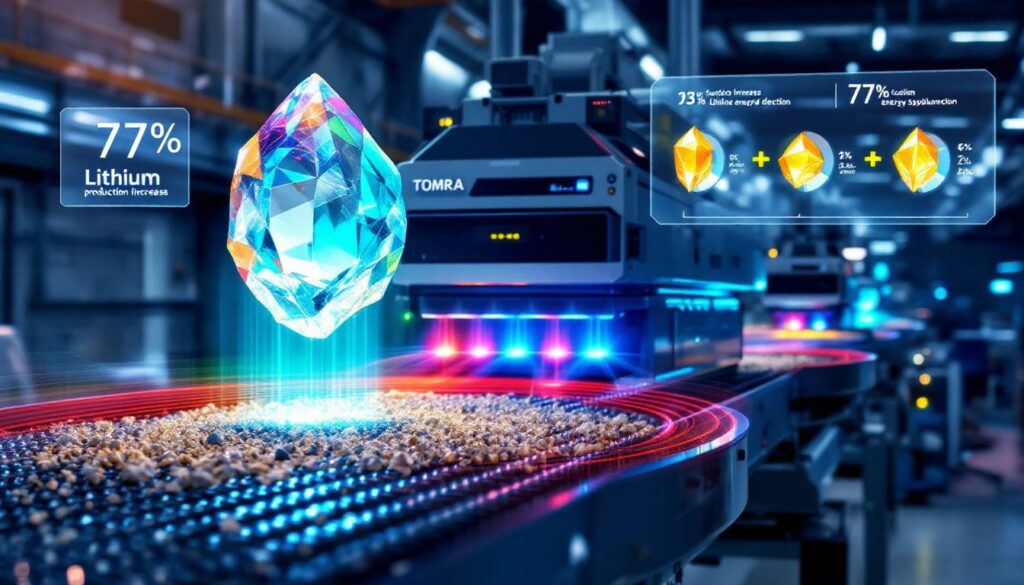How Sensor-Based Sorting Is Transforming Lithium Mining
The lithium mining industry is experiencing a technological revolution with sensor-based sorting emerging as a game-changing innovation. Traditional lithium processing methods have long struggled with efficiency challenges, including high energy consumption, excessive water usage, and difficulty separating valuable lithium-bearing minerals from waste material. These limitations have driven the search for more sustainable and economical solutions in an industry facing unprecedented demand from the global energy transition.
Sensor-based sorting technologies have emerged as a powerful answer to these challenges, offering precision separation capabilities that were previously unattainable. These advanced systems utilize sophisticated sensors to identify and separate lithium-bearing minerals from waste rock with remarkable accuracy, fundamentally transforming resource efficiency in the lithium supply chain.
The Evolution of Lithium Ore Processing
Traditional lithium processing methods have relied heavily on dense media separation (DMS), flotation, and other concentration techniques that often require significant water and energy inputs. These conventional approaches frequently struggle with variable ore grades and complex mineralogy, leading to suboptimal recovery rates and higher processing costs.
The introduction of sensor-based sorting represents a paradigm shift in lithium beneficiation. By implementing early-stage waste rejection, these systems can effectively remove barren host rock before it enters downstream processing circuits. This capability addresses one of the industry's most persistent challenges: managing valuable spodumene ore within non-valuable host material.
As Dale Henderson, CEO of Pilbara Minerals, noted: "The ore sorter helps us get more of the ore from the ore body and helps clean it to further improve recoveries—it really is the secret sauce." This executive perspective highlights the transformative potential of sensor-based sorting in optimizing lithium operations.
Understanding Sensor-Based Sorting Technology
Sensor-based sorting systems employ multiple detection technologies to precisely identify lithium-bearing minerals:
- X-ray Transmission (XRT): Detects density differences between minerals, allowing for effective separation of spodumene from waste rock
- Color Sorting: Identifies visual differences between mineral types, particularly effective for coarser particle sizes
- Multi-sensor Integration: Combines different detection methods for optimal sorting performance across varied ore types
These technologies enable highly selective mineral separation based on the physical and chemical properties of the target materials. Rather than processing all mined material through energy-intensive circuits, sensor-based sorting allows operations to concentrate resources on valuable mineral fractions while rejecting waste early in the process.
The key advantages over conventional beneficiation methods include:
- Reduced energy and water consumption
- Lower processing costs for downstream operations
- Enhanced recovery of valuable minerals
- Improved concentrate grades
- Minimized environmental footprint
What Makes the Pilgangoora Operation's Sorting Plant Revolutionary?
The implementation of TOMRA Mining technology in lithium sorting at Pilbara Minerals' Pilgangoora Operation represents a landmark achievement in lithium processing innovation. Commissioned in August 2024 as part of the P680 Expansion Project, this facility stands as a testament to what advanced sensor-based sorting can accomplish at industrial scale.
World's Largest Lithium Sorting Facility
The Pilgangoora sorting plant processes more than 1,000 tonnes per hour, making it the world's largest lithium ore sorting facility. This unprecedented scale demonstrates the technology's viability for major mining operations and its potential to impact global lithium supply chains significantly.
The strategic importance of this installation extends beyond a single operation. As a pioneering implementation of large-scale sensor-based sorting in lithium mining, the Pilgangoora facility establishes new benchmarks for resource efficiency in critical minerals processing. It represents a crucial step toward meeting the growing demand for lithium in electric vehicle batteries and energy storage systems while addressing sustainability concerns.
Key development milestones included:
- Extensive testwork at TOMRA's Sydney Test Center
- Collaborative engineering design between TOMRA Mining, Pilbara Minerals, and DRA Global
- Integration with existing processing infrastructure
- Successful commissioning within project timeline and budget constraints
- Achievement of performance targets during production ramp-up
Technical Configuration and Equipment
The sorting plant's sophisticated technical configuration includes ten high-precision TOMRA sorters working in concert:
- 4 TOMRA COM Tertiary XRT units processing fines
- 3 TOMRA COM XRT 2.0 units handling mid-sized particles
- 3 TOMRA PRO Primary Color units sorting coarse-sized particles
This multi-technology approach optimizes particle size sorting across the entire feed spectrum, enabling comprehensive waste rejection regardless of material characteristics. The system's design allows for efficient processing of varied ore domains, providing operational flexibility as mining progresses through different areas of the deposit.
The integration with existing processing infrastructure was carefully engineered to minimize disruption while maximizing the benefits of early waste rejection. By removing non-valuable material before it enters downstream circuits, the sorting plant reduces the burden on subsequent processing stages, enhancing overall plant throughput and efficiency.
What Measurable Benefits Has Sensor-Based Sorting Delivered?
The implementation of TOMRA Mining's sensor-based sorting technology at the Pilgangoora Operation has generated impressive, quantifiable benefits across multiple performance metrics. These results validate the transformative potential of advanced sorting in lithium mining operations.
Production and Efficiency Gains
The impact on production volumes has been remarkable, with official figures demonstrating a 77% increase in production volume during the June Quarter FY25. This substantial growth in output coincided with a 10% reduction in unit operating costs (FOB) compared to the previous quarter, highlighting the dual benefit of increased production and improved cost efficiency.
Energy consumption has also seen significant improvement, with annual savings estimated at 8-15 GWh. This reduction not only lowers operational costs but also enhances the operation's sustainability profile at a time when environmental considerations are increasingly important to stakeholders and customers.
Gavin Rech, Area Sales and Technical Manager Australia at TOMRA Mining, observed that "The June Quarter marked the strongest performance of the year, clearly demonstrating the impact that TOMRA's technology can deliver at scale." This performance validation from both the technology provider and operational results confirms the technology's effectiveness in real-world mining conditions.
Resource Optimization Impacts
Beyond immediate production gains, the sensor-based sorting implementation has delivered strategic resource optimization benefits. As Gavin Rech explained, "By unlocking value from lower-grade contact ore previously considered uneconomical, the operation now accesses more lithia units from the pit, enhancing resource utilisation and mine flexibility."
This capability to process previously marginal material effectively extends the economic resource base of the operation, improving the mine's overall net present value. The ability to efficiently handle variable ore types also provides operational resilience against geological uncertainty and changing market conditions.
Key resource optimization impacts include:
- Expanded economic resource base: Material previously classified as waste can now be processed profitably
- Enhanced mine planning flexibility: More options for sequencing extraction based on varying ore types
- Improved overall resource recovery: Higher percentage of contained lithium ultimately recovered
- Extended mine life potential: Through more efficient utilization of the entire resource
How Does the Technology Address Specific Lithium Mining Challenges?
Lithium mining presents unique technical challenges that have historically limited recovery efficiency and economic viability. Sensor-based sorting technology directly addresses several of these persistent industry hurdles, providing solutions that conventional processing methods could not achieve.
Managing Spodumene Within Host Rock
One of the most significant challenges in lithium mining is effectively separating valuable spodumene from waste material, particularly when the visual and physical distinctions between ore and waste are subtle. Sensor-based sorting excels at this crucial task through its sophisticated detection capabilities.
The XRT technology can detect density differences between spodumene and host rock even when these differences are minor, allowing for effective separation of value-bearing material. Color sorting further enhances this capability by identifying visual distinctions that might be imperceptible to the human eye or conventional separation methods.
This targeted separation ability is particularly valuable in pegmatite deposits like Pilgangoora, where spodumene distribution can be highly variable within the host rock. The testing conducted at TOMRA's Sydney Test Center demonstrated the technology's capability to deliver high lithium recovery and effective waste separation across varied ore domains, confirming its adaptability to changing geological conditions.
Upstream Waste Removal Benefits
By implementing sorting technology early in the processing circuit, the Pilgangoora operation achieves significant downstream benefits:
- Reduced processing requirements: Removing waste before it enters energy-intensive crushing and grinding circuits reduces wear on equipment and lowers energy consumption
- Decreased water consumption: Less material requiring wet processing translates to lower water requirements
- Lower reagent usage: With fewer tonnes processed through chemical separation stages, reagent consumption decreases proportionally
- Minimized tailings generation: Early waste rejection means less material ultimately reports to tailings storage facilities
These benefits compound throughout the operation, creating a cascading positive effect on both operational costs and environmental impact. The reduced environmental footprint aligns with growing industry emphasis on sustainable mining practices and responsible resource development.
What Was the Development and Implementation Process?
The successful implementation of the world's largest lithium sorting facility resulted from meticulous planning, extensive testing, and strong collaboration between technology provider, mine operator, and engineering partner. This methodical approach ensured the project's delivery on time and on budget despite its innovative nature and unprecedented scale.
Collaborative Engineering Approach
The development process began with a collaborative partnership between TOMRA Mining, Pilbara Minerals, and engineering firm DRA Global. This tripartite arrangement combined TOMRA's sorting expertise, Pilbara Minerals' operational knowledge, and DRA Global's engineering capabilities to create an integrated solution tailored to the specific challenges of the Pilgangoora deposit.
The project timeline spanned several years, progressing through multiple phases:
- Initial concept development: Identification of sorting technology potential for the Pilgangoora expansion
- Laboratory testing: Preliminary analysis of ore samples to establish technical feasibility
- Pilot-scale trials: Testing at TOMRA's Sydney Test Center to validate performance at larger scale
- Engineering design: Detailed system design incorporating site-specific requirements
- Procurement and construction: Equipment manufacturing and on-site installation
- Commissioning: Systematic startup and optimization of the sorting circuit
- Performance verification: Monitoring and assessment against design targets
Throughout this process, extensive testing demonstrated the technology's capability to deliver high lithium recovery and effective waste separation across varied ore domains, providing confidence in the solution before full-scale implementation.
Project Execution Success Factors
Several key factors contributed to the successful execution of this groundbreaking project:
- Comprehensive test work: Thorough validation of the sorting technology's performance with Pilgangoora ore provided a solid foundation for design decisions
- Integrated project team: Close collaboration between all stakeholders ensured alignment on objectives and approach
- Phased implementation: Methodical commissioning strategy allowed for systematic troubleshooting and optimization
- Knowledge transfer: Structured training programs prepared operational personnel for the new technology
- Performance monitoring systems: Advanced data collection and analysis capabilities enabled continuous improvement
The project's delivery on time and on budget demonstrates the maturity of sensor-based sorting technology for lithium applications, despite the unprecedented scale of the installation. This successful implementation establishes a blueprint for future applications in the lithium industry and other critical minerals sectors.
How Does This Technology Support Long-Term Strategic Goals?
The implementation of sensor-based sorting technology at Pilgangoora aligns with broader strategic objectives beyond immediate operational improvements. This technology investment positions the operation advantageously for future market conditions and expansion opportunities while supporting sustainability commitments.
Cost Optimization and Sustainable Growth
In an industry characterized by price volatility and increasing cost pressures, the ability to optimize production costs provides significant competitive advantage. The 10% reduction in unit operating costs achieved through sorting technology implementation strengthens the operation's position on the global cost curve, enhancing resilience against market fluctuations.
The technology also supports sustainable growth ambitions by:
- Reducing carbon intensity: Lower energy consumption translates to reduced carbon emissions per tonne of lithium produced
- Minimizing water usage: Particularly valuable in water-stressed regions where lithium operations often occur
- Enhancing resource utilization: More efficient extraction from the same resource base aligns with circular economy principles
- Improving social license: Demonstrating commitment to best-available technology for environmental performance
These sustainability advantages complement the financial benefits, creating a compelling value proposition that aligns with increasing market and regulatory emphasis on responsible resource development. As lithium consumers increasingly scrutinize the environmental credentials of their supply chains, these attributes may translate into preferred supplier status and potential price premiums.
Future Expansion Capabilities
The sensor-based sorting facility plays a strategic role in Pilbara Minerals' broader expansion plans, including the P2000 project feasibility study. The demonstrated success of the technology creates a proven template for scaling processing capacity while maintaining efficiency and sustainability advantages.
Key aspects of the technology's scalability include:
- Modular design: Additional sorting units can be integrated into existing infrastructure as needed
- Adaptable configuration: Sorting parameters can be adjusted to accommodate changing ore characteristics
- Performance optimization potential: Continuous improvement through operational data analysis and technology upgrades
- Throughput flexibility: Ability to handle variable feed rates and ore types provides operational resilience
This flexibility supports phased expansion approaches that can respond to market conditions and capital availability, reducing project risk while maintaining growth potential.
What Are the Broader Industry Implications?
The successful implementation of TOMRA Mining technology in lithium sorting at this unprecedented scale establishes new benchmarks for the entire lithium industry. Its demonstrated benefits are likely to influence technology decisions across the sector and potentially in other critical minerals applications.
Setting New Standards for Lithium Processing
The Pilgangoora sorting facility demonstrates what's possible with current technology, challenging conventional assumptions about lithium processing approaches. Its success establishes sensor-based sorting as a proven option for major lithium developments rather than an experimental technology.
This implementation is likely to influence industry best practices in several ways:
- Processing flowsheet design: Early waste rejection may become standard practice in new lithium developments
- Resource evaluation criteria: Lower cut-off grades may be economically viable with sorting technology
- Capital allocation decisions: Technology investments may be prioritized over traditional capacity expansion
- Environmental impact assessments: Lower baseline assumptions for water and energy intensity
Other lithium producers are likely to evaluate similar implementations, particularly as they pursue expansion projects or operational improvements. The demonstrated benefits provide compelling justification for technology adoption despite the initial capital investment required.
Resource Efficiency in Critical Minerals
The principles and benefits demonstrated in this lithium application have relevance across the broader critical minerals sector. As the global transition to clean energy accelerates, efficient extraction and processing of battery materials, rare earth elements, and other technology metals become increasingly important.
Sensor-based sorting technology contributes to responsible resource development by:
- Maximizing recovery from existing operations: Reducing the need for greenfield development
- Minimizing processing intensity: Lowering the environmental footprint of mineral production
- Enabling lower-grade resource utilization: Expanding the viable resource base without proportional impact increase
- Supporting supply chain resilience: Improving production efficiency and resource flexibility
These contributions align with circular economy principles and support the sustainable development of critical mineral supply chains necessary for global energy transition. The demonstration of these benefits at industrial scale provides valuable validation for technology adoption decisions across the mining sector.
What Do Industry Leaders Say About the Technology?
Industry perspectives on the TOMRA Mining technology implementation at Pilgangoora provide valuable insight into its significance and performance. Leaders from both the mining operation and technology provider have shared observations that highlight different aspects of the technology's impact.
Expert Perspectives
Dale Henderson, CEO of Pilbara Minerals, characterized the ore sorting system as "the secret sauce" in the operation's impressive performance improvements. This executive-level endorsement underscores the strategic importance placed on the technology as a competitive differentiator rather than merely an incremental improvement.
Henderson elaborated that "The ore sorter helps us get more of the ore from the ore body and helps clean it to further improve recoveries," highlighting both the resource utilization and processing efficiency benefits of the technology. This dual advantage represents a powerful value proposition for operations facing similar challenges.
From the technology provider perspective, Gavin Rech noted that "The June Quarter marked the strongest performance of the year, clearly demonstrating the impact that TOMRA's technology can deliver at scale." This statement validates that the system's performance meets or exceeds expectations in real-world mining conditions, not just laboratory environments.
Performance Validation
The most compelling validation comes from operational results rather than claims. The reported 77% increase in production volume and 10% reduction in unit operating costs provide quantifiable evidence of the technology's effectiveness that transcends promotional statements.
These performance metrics align with the anticipated benefits of sensor-based sorting technology:
- Increased throughput: By removing waste early, downstream bottlenecks are relieved
- Improved recoveries: More efficient separation leads to less lithium loss to tailings
- Reduced operating costs: Lower energy, water, and reagent consumption per tonne of final product
- Enhanced resource utilization: Previously marginal material becomes economically viable
The consistent achievement of these benefits during commercial operation provides strong validation of the technology's capabilities and justifies the capital investment required for implementation.
FAQ: Sensor-Based Sorting in Lithium Mining
What specific minerals can sensor-based sorting detect in lithium ore?
Sensor-based sorting technologies can effectively identify and separate several minerals commonly found in lithium deposits:
- Spodumene: The primary lithium-bearing mineral in hard-rock deposits
- Petalite: Another lithium-bearing mineral sometimes present in pegmatites
- Lepidolite: Lithium-rich mica that can be challenging to process
- Feldspar: Common gangue mineral in lithium pegmatites
- Quartz: Major component of host rock that can be effectively rejected
- Mica: Often associated with lithium pegmatites but typically considere
Want to Capitalise on the Next Major Mineral Discovery?
Discovery Alert's proprietary Discovery IQ model provides instant notifications when significant mineral discoveries occur on the ASX, turning complex data into actionable investment insights. Explore why major discoveries like those at Pilgangoora can generate substantial returns by visiting Discovery Alert's dedicated discoveries page and begin your 30-day free trial today.




